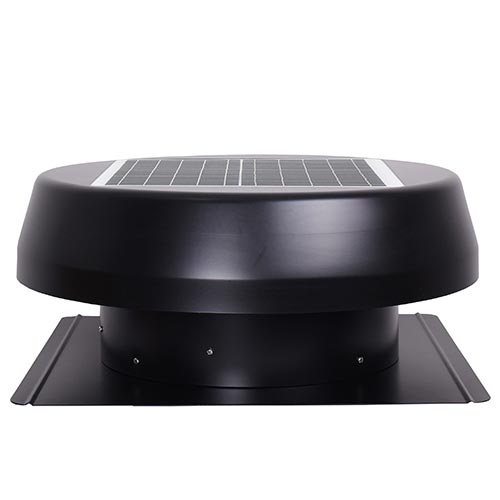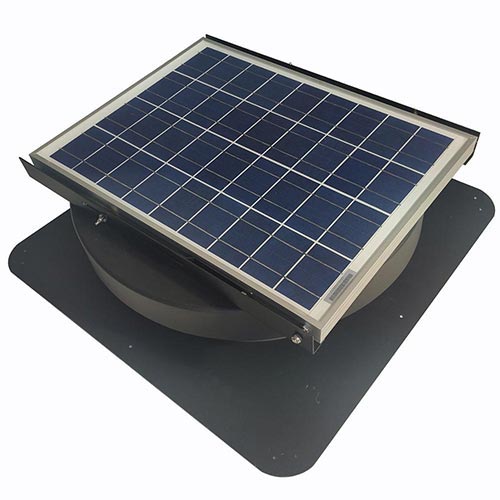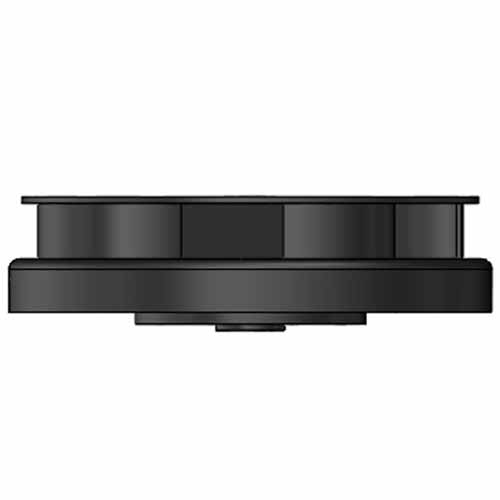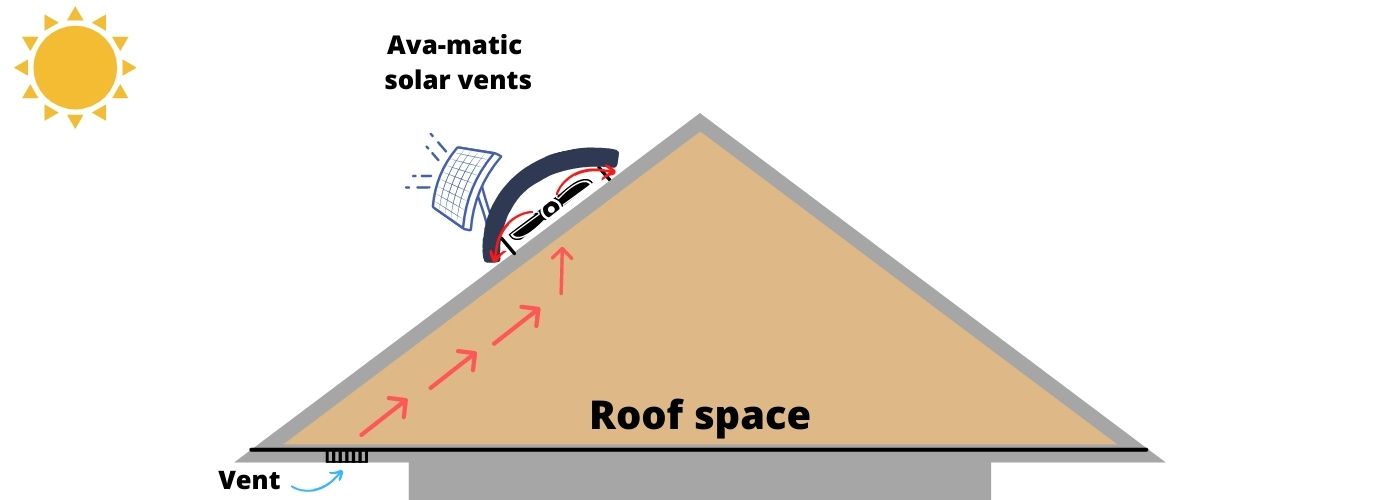The solar roof vents
The solar roof ventilator is a simple and economical solution for cooling your home, very effective in summer and winter, they are designed to protect your home.
You will find in this article all on the solar roof ventilators, their importance as well as their functioning.
How do solar roof ventilators work ?
They have a thermostat that automatically controls the ventilator fan, turning it on when the roof cavity heats up and silently removing heat from your roof or ceiling.
The importance of good roof ventilation :
Roof ventilation can be achieved through a roof space, or attic space, that allows air to circulate. This space is usually located between the roofing and the insulation, whether it is insulation material or a roof underlayment. To create a draft, ventilation devices are installed at various locations on the roof. These are usually air inlets and outlets at the bottom and top of the roof.
Without this ventilation gap, the various roofing materials would be as if enclosed in a confined space, which would lead to various problems such as :
Moisture and water vapor: your roof would be more susceptible to water infiltration, the wood of the frame could rot and the insulation material would become waterlogged.
Mould: If there is no venting, humidity will stagnate and eventually cause mould problems on the roof structure as well as wood-rot, but also under the tiles which could then become porous.
Fungi: as a corollary of mold, fungi also develop in the presence of constant
humidity. And without ventilation, the humidity will remain under your roof.
Overheating: roofs that are very exposed in summer can become overheated, causing premature wear of materials and increased heat inside buildings. That’s why your roof need to be vented.
The renewal of the air under the roof is therefore essential for several reasons, in addition to avoiding this type of problem, namely :
- To ensure the longevity of the various roofing elements.
- To maintain a healthy integrity of the roofing elements.
- To dry the rain after bad weather.
- Avoiding condensation.
- Contribute to the consistency of the insulation and improve its performance.
How to ventilate a roof ?
Several solutions exist to ventilate your roof: ventilation tiles, catches, ventilated eaves or closoirs. To make the right choice, you must take into account several criteria such as the type of roof, the roofing material and the insulation method in place. Indeed, each of these devices is more or less adapted according to the configuration of the roof of your house. Moreover, you have several actions to take in order to ensure a good ventilation of your roof and to avoid the inconveniences, even the serious problems mentioned before.
A professional will be able to advise you on your specific case to ventilate your roof in an efficient way. Here’s what you need to do to properly vented your roof.
The role of the roof void
The ventilation of the roof is possible thanks to the space under the roof. To allow air to circulate in this confined space, air must be able to flow in and out and under the roof. The under-roof space ensures this function by leaving a minimum space between the materials in order to allow a good ventilation.
It is created thanks to the counter-lintels and must be at least 2 cm thick. It comes in principle after the under-roof screen. This space allows the materials to breathe and prevents condensation by evacuating humidity and stale air. In the case of an attic conversion or an attic, it is important to keep an air space when installing the insulation.
The role of roof waterproofing
Next comes the waterproofing of the roof and the roofing, which allows the structure to be watertight. This is useful to avoid air exchanges between the outside and inside. In fact, the more homogeneous the waterproofing, the more efficient the ventilation. This waterproofing is ensured by the under-roof screen for recent constructions or after a renovation. But it can be completed with an air screen placed on the lower part of the roof. and with the help of the sealant.
The role of the roof ventilation
Once the roof is completely sealed, the roof space must be accompanied by ventilation fans. These elements will ensure a ventilation role in order to evacuate the stale air to the benefit of a new and healthy air. This natural ventilation in the roof space also allows to dry the roof elements such as the concrete slab, the frame and the wooden lintels, …
But for the ventilation to be effective, professional roofers recommend to respect two rules:
Ventilation must be installed along the entire length of the roof.
The number of air inlets must be similar to the number of air outlets.
For a sloping roof, it is sufficient to create an air circulation between the top and bottom of the roof. However, older buildings often have a ridge that is set in mortar, so only ventilation tiles can be installed. For the ventilation of a flat-roof, it will be necessary to use ventilation battens.
Solutions for roof ventilation
As you can see, whole house fans is important for the durability of your roof. When building or renovating your roof, ventilation systems must be installed. But it is still necessary to choose the good vent fans system because several solutions are offered to you, namely:
- Ventilation tiles.
- Ventilation holes.
- The ventilated ridge cap.
Let’s go into the details of these different solutions of roof ventilation.
The ventilation tiles
As a basic roofing tile, clay tiles allow a little air to pass through their rounded shape. But this air flow is minimal and to accentuate the phenomenon, one or more ventilation tiles are installed. As their name indicates, these tiles have the function of ensuring the ventilation of the roof. They allow air to pass through thanks to their shape creating an opening in the roof.
The installation of ventilation tiles is an ideal solution for tile roof or slate roof. Indeed, the ventilation tile blends in with the rest of the roofing. Tiles with a really rounded shape are already naturally prone to letting air through. These are the canal tiles. Their prices vary from 0,60€ to 2€ a piece.
Ventilated gutters and eaves
Ventilated gutters are specs tiles used for the ventilation of sloping roofs. They are usually positioned at the top and bottom of the roof to generate an upward air flow.
Roof vents are sometimes equipped with a grid to prevent the passage of dust and small animals. They come in many shapes and colors to blend in with your roof. They can be made of clay or zinc.
The price of cat flaps or ventilated gutters varies as follows:
- Clay cat flap tiles: between 15$ and 50$ each.
- Zinc ridge tiles: between 30$ and 60$ each.
Ventilated ridge cap
The ridge cap is a Sealing and ventilating system for the upper part of the roof and comes in the form of rolls or strips.
This equipment has the function of protecting the ridge from water infiltration, dust, pollen and pollution. The high ventilation is thus ensured without having to fear humidity. The ridge is ventilated and allows the circulation of hot air or fresh-air in the gap between the gutters at the bottom of the roof and the ridge at the top. A ridge cap costs about 35$.
Specificity of metal roof ventilation
The ventilation of metal roofs has some particularities. Indeed, if the roof is insulated, it is called a warm roof. In this case, the ventilation must be installed according to specific rules set by the DTU in order to avoid condensation phenomena that can lead to the oxidation of materials. To do this, here is how to proceed.
Ventilation for a steel roof
The steel roof requires ventilation as described above. But in addition, the roof must be punctuated with lanterns. These lanterns are a kind of small ventilation chimney topped by a cap. They are installed at regular intervals to boost the existing ventilation. The lanterns can be replaced by cat flaps.
Ventilation for a zinc roof
Zinc is particularly prone to condensation. Therefore, an additional ventilation as for warm steel roofs is essential. In this case, the installation of zinc catches at regular intervals will increase the flow of indoor air and thus the ventilation.
Does a solar roof vent work at night ?
There are no batteries on the ava-matic fan vent that store energy. Thus, they only work when daylight is available on the solar panel.
Therefore, a solar roof fan will still allow natural air convection at night, but there are alternatives such as having an extra battery.
How to choose your solar roof ventilator ?
Solar powered fan are much more efficient than whirlybird roof ventilators, but there are many more criteria to consider when choosing a good solar roof ventilator.
Criteria for a good solar roof ventilator
The performance
The most important indicators to know if you have chosen the right solar roof ventilator are :
- the power of the solar panel
- diameter of the exhaust fan.
The manufacturer
The manufacturer and the warranties he offers are important things to consider, that’s why we advise you to choose companies that have a certain age to be sure that can answer all your questions and specific requests, Ava matic is a supplier of ventilation since 1954 and reached a certain credibility in the field of ventilation, click
here to learn more.
The installation system
The installation systems are different from one country to another, that’s why we invite you to read the details of each product, ava matic offers solar roof ventilators adaptable for any country and for any type of roof, if you have any questions please contact us here.
The price
The price is a factor to take into account because in most cases price = quality, that’s why we don’t recommend solar roof ventilators with a price under 400$, generally the quality is not there!
Good quality solar roof ventilators are priced from $500 up to $1000,
How many degrees will a solar roof vent lower the temperature of a home ?
The temperature of the interior of the house will certainly drop with a solar roof vent, however, it is impossible to give a figure as it will depend on certain external factors such as
- The current insulation of the house
- the materials of the roof
The ideal way to get an estimate of how many degrees the temperature of your home will drop is to measure the temperature in the roof cavity as the temperature in the roof cavity can easily reach 60°C therefore, the exchange of this air with colder air from outside will have a major impact on the interior temperature.









